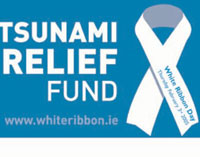 |
| White Ribbon Day is marked on 25 November each year and is an opportunity for governments, businesses and community groups to focus on a problem that affects many people throughout the world. |
Have you heard of "white ribbon" campaign? A white ribbon is not abadgeof purity or perfection. It simply says you believe that violence against women is unacceptable. Wear a white ribbon on November 25.
White Ribbon Day is marked on 25 November each year and is an opportunity for governments, businesses and community groups to focus on a problem that affects many people throughout the world.
The White Ribbon Campaign is the largest effort in the world of men working to end men's violence against women, and wearing a white ribbon is seen as a personalpledgenever to commit, condone or remain silent about violence against women.
Violent crimes committed against women and girls - like domestic violence, sexual assault andpeople trafficking- continue to be pervasive around the world. Violence against women and girls affects everyone in the community. Men's lives are personally affected if their girlfriends, wives, daughters, mothers, grandmothers or sisters experience violence or the threat of violence.
 A history of the day A history of the day
In 1991, a handful of men in Canada decided that they had a responsibility to urge men to speak out against violence against women. They decided that wearing a white ribbon would be a symbol of men's opposition to men's violence against women.
After only six weeks preparation, as many as one hundred thousand men across Canada wore a white ribbon. Many others were drawn into discussion and debate on the issue of men's violence.
 Voice of men wearing white ribbons Voice of men wearing white ribbons
Men wear white ribbons on November 25 each year because:
We know that a fist in the face, a kick in the ribs, being forced into sex, and having one's daily life controlled and policed and tormented, are horrible things that should never happen.
We care for our wives, our girlfriends, our sisters, daughters, our female friends, our co-workers.
We know it is men's wives, mothers, sisters, daughters, and friends whose lives are limited by violence and abuse; and, whether we know about it or not, many of the women we know have been subject to men's violence.
We know that men don't have to be violent, that men can do better, that men can be and often are loving, caring, and nonviolent.
We want girls and women, and boys and men, to be free from the threat of other men's violence.
We know that men will benefit from a world free of violence against women, a world based on gender equality: in our relations with women, instead of experiencing distrust and disconnection we will find closeness and connection. We will be able to take up a healthier, emotionally in-touch and proud masculinity.
 The White Ribbon Day in China The White Ribbon Day in China
The United Nations Development Fund for Women (UNIFEM) introduced the campaign to China in 2001.
The new Chinese group is a community-based organization composed of lawyers, doctors, journalists, college students and teachers, community workers and other social workers.
A written statement from the group calls on the whole of society, particularly men, to oppose any kind of violence against women, to never commit, condone or remain silent about violence against women, to offer the best possible assistance to women victims of violence, especially domestic violence, and to make positive contributions to the elimination of violence against women and to gender equality.
The White Ribbon Campaign has been so far introduced to local communities in Northeast China's Liaoning Province, East China's Jiangxi Province, Northwest China's Shaanxi Province and Central China's Hunan Province.
 Background Background
"白丝带"活动的发起:1989年年底,加拿大一名男子因认为发展机会都被女性夺走了,于是在蒙特利尔一所大学内,枪杀了十四名年轻女子后自杀。两年后,一群男性期望社会大众应该从这悲剧中来反省,男性不该再对男人加诸女人的暴力保持沉默,所以发起了这个运动。目前白丝带运动已扩展到美、欧、澳以及南非等地,加拿大每年几乎有50万人配带白丝带。白丝带运动的发起组织鼓励男士在每年11月25日"国际消除对妇女的暴力日"到12月6日加拿大"对妇女的暴力国家纪念行动日"期间佩戴白丝带。
"白丝带"活动的由来:消除对妇女的暴力是社会的共同责任。
"白丝带"的含义:佩戴白丝带是一种个人宣言,表示佩戴者承诺本人绝不参与对妇女施暴,并且对针对妇女的暴力决不保持沉默。
"白丝带"活动在中国:中国第一次"白丝带"活动是在2001年"三八国际妇女节"前2月15日举办的。
(英语点津陈蓓编辑)
|